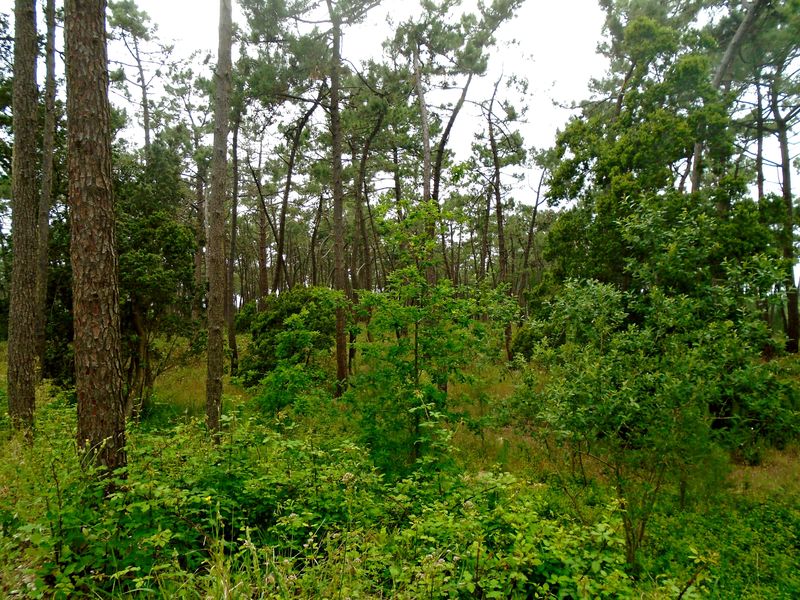Variante verde ao Trilho de Descoberta da Natureza
Share Image
The forest S. Jacinto is a resinous forest, with a little over 100 years (it was planted in the early 20th century), being essentially used maritime pine for consolidation of the dunes. It is currently a mixed forest, predominantly in areas with higher elevation and therefore drier, softwoods, in addition to Maritime Pine (Pinus pinaster), Phoenician Juniper (Juniperus phoenicia), Candleberry Myrtle (Myrica faya) Common Gorse (Ulex europaeus), Broom (Cytisus grandiflorus) and Salvia Cistus (Cistus salvifolius). On the lower and wetter areas are the broadleaf species, especially willows (Salix atrocinerea), alder (Alnus glutinosa) and poplars (Populus nigra) and Creeping Willow (Salix repens). In this forest, these corridors of broadleaf species play an important role due to its greater resistance to fire and its considerable production of dead leaves, enriching the soil with organic matter, allowing species diversification of in these habitats. A carefully marked trail allows visitors a close contact with a diversified space and, who knows, if you will have the sound of the sea, the birds singing and always the silence as company.

-
The forest S. Jacinto is a resinous forest, with a little over 100 years (it was planted in the early 20th century), being essentially used maritime pine for consolidation of the dunes. It is currently a mixed forest, predominantly in areas with higher elevation and therefore drier, softwoods, in addition to Maritime Pine (Pinus pinaster), Phoenician Juniper (Juniperus phoenicia), Candleberry Myrtle (Myrica faya) Common Gorse (Ulex europaeus), Broom (Cytisus grandiflorus) and Salvia Cistus (Cistus salvifolius). On the lower and wetter areas are the broadleaf species, especially willows (Salix atrocinerea), alder (Alnus glutinosa) and poplars (Populus nigra) and Creeping Willow (Salix repens). In this forest, these corridors of broadleaf species play an important role due to its greater resistance to fire and its considerable production of dead leaves, enriching the soil with organic matter, allowing species diversification of in these habitats. A carefully marked trail allows visitors a close contact with a diversified space and, who knows, if you will have the sound of the sea, the birds singing and always the silence as company.
-
Center
-
Aveiro
-
S. Jacinto Dunes Nature Reserve
Base Characterization
-
PTZPE0004 Ria de Aveiro
PTCON0061 Ria de Aveiro
-
Instituto da Conservação da Natureza e das Florestas, I. P.
Route Characterization
-
Access coming from north:
- A29, exit north Ovar towards Furadouro, Torreira and S. Jacinto or
- A1, exit at Fair node towards Ovar and follow the same route.
Access coming from south:
- A1 or A25 exit at Estarreja node. Follow towards Estarreja, Murtosa, Torreira and S. Jacinto;
- Aveiro, follow towards the beaches. Turn toward the Commercial Port, and the Forte da Barra in ferryboat, make the crossing to S. Jacinto.
By train - exit at Aveiro station. There are buses to the fort of Barra where you can take the boat to S. Jacinto.
Note: Natural Reserve information services are 1 km away from the village of S. Jacinto in N327. The boat and the ferryboat have Summer and Winter schedules.
GPS: 40.670948, -8.725001
-
No
-
Information center of Dunas de S. Jacinto Nature Reserve
-
Information center of Dunas de S. Jacinto Nature Reserve
-
3.3 km
-
All year long
-
1:30 h
-
8 meters (between 2 and 10 m)
-
Easy
-
Ring road
-
Todos os grupos
Supports in place
-
Diretional signs.
-
Resting areas with seats. Observatories.
Topographic Profile
Bring water and a snack, hat, comfortable walking shoes, insect repellent and sunscreen.
Access coming from north:
- A29, exit north Ovar towards Furadouro, Torreira and S. Jacinto or
- A1, exit at Fair node towards Ovar and follow the same route.
Access coming from south:
- A1 or A25 exit at Estarreja node. Follow towards Estarreja, Murtosa, Torreira and S. Jacinto;
- Aveiro, follow towards the beaches. Turn toward the Commercial Port, and the Forte da Barra in ferryboat, make the crossing to S. Jacinto.
By train - exit at Aveiro station. There are buses to the fort of Barra where you can take the boat to S. Jacinto.
Note: Natural Reserve information services are 1 km away from the village of S. Jacinto in N327. The boat and the ferryboat have Summer and Winter schedules.
GPS: 40.670948, -8.725001














